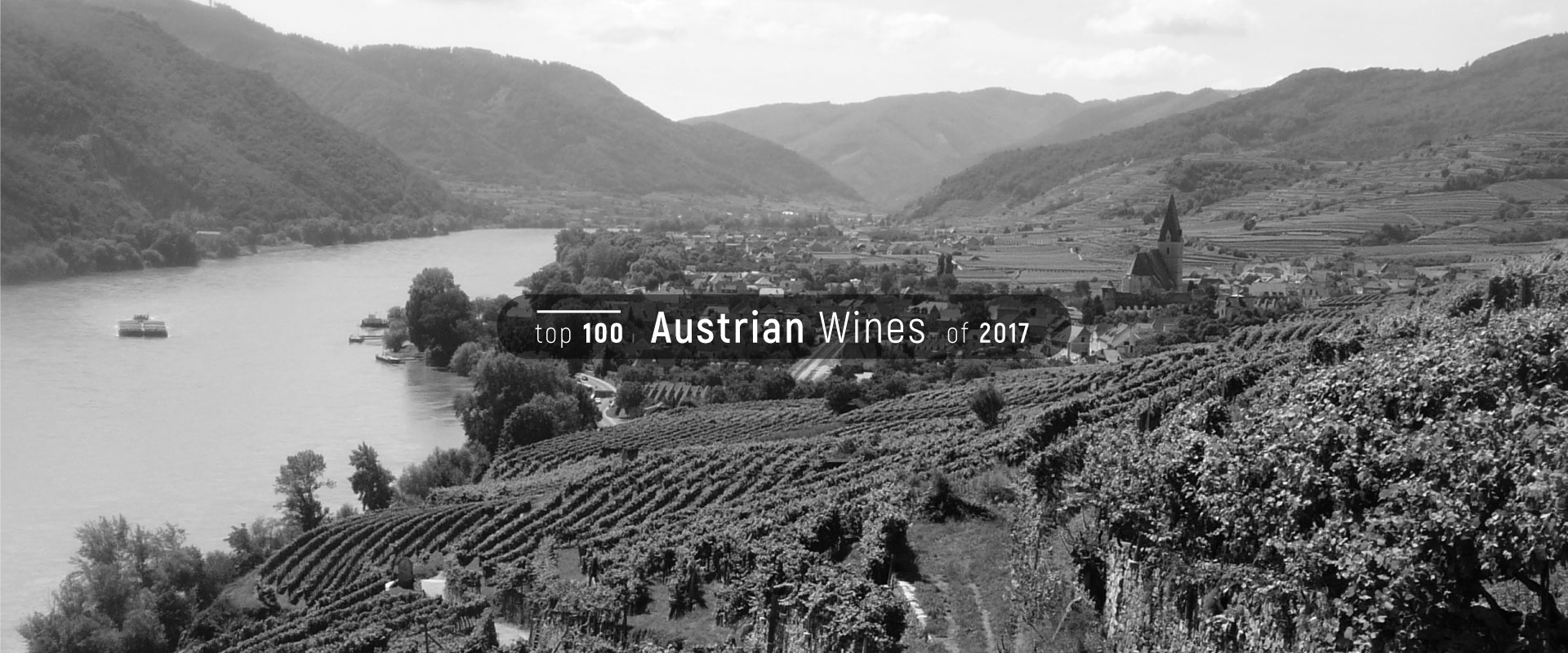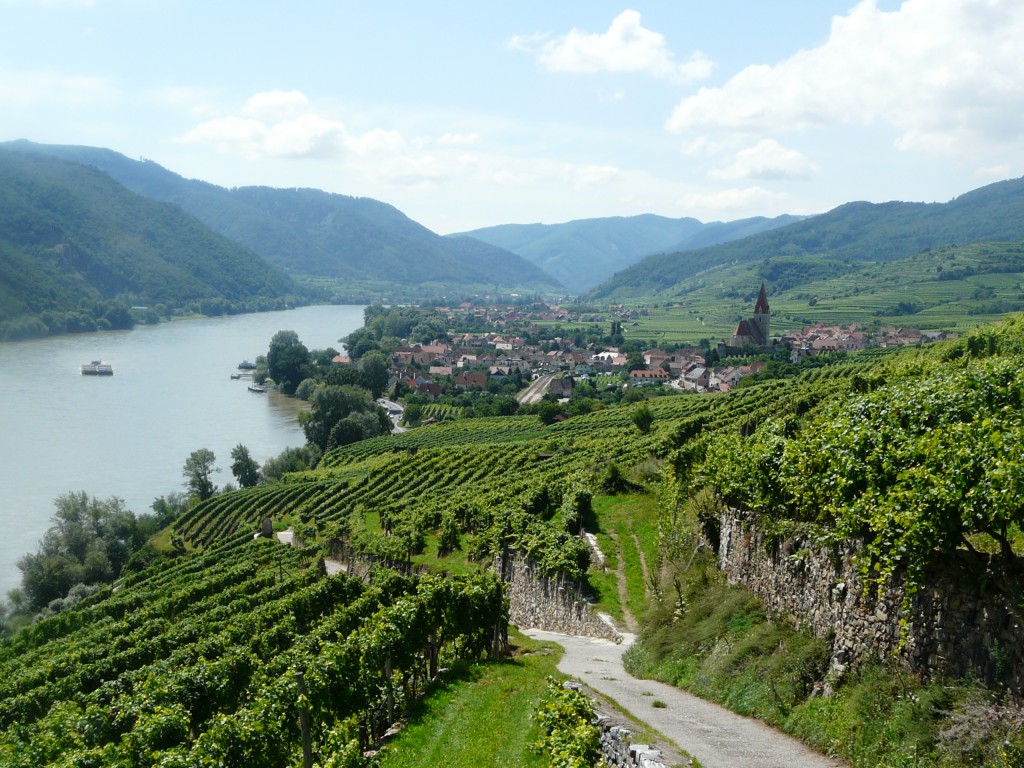Top 100 Austrian Wines of 2017
 We’re often asked what makes a wine receive a rating of 100 points, and our Austrian Wine of the Year 2017, the F.X. Pichler Riesling Ried Kellerberg Smaragd 2016 in Loiben, Wachau, is a perfect example of what we’re looking for in the greatest wines on Planet Wine. An encounter with a 100-point wine always has to be love at first sip, and that moment of revelation should be free of any doubt. However, then as we dissect the experience, we recognize that not only does the wine deliver everything you could want from with this grape and region, but it also has perfect balance. Without that, there’s no possibility of giving 100 points.
We’re often asked what makes a wine receive a rating of 100 points, and our Austrian Wine of the Year 2017, the F.X. Pichler Riesling Ried Kellerberg Smaragd 2016 in Loiben, Wachau, is a perfect example of what we’re looking for in the greatest wines on Planet Wine. An encounter with a 100-point wine always has to be love at first sip, and that moment of revelation should be free of any doubt. However, then as we dissect the experience, we recognize that not only does the wine deliver everything you could want from with this grape and region, but it also has perfect balance. Without that, there’s no possibility of giving 100 points.
Sometimes, it is suggested that all our 100-point wines have some superficial similarity, like lush fruit or a sweet impression (dry wines can also taste this way through a combination of high alcohol and low acidity), but that’s certainly not the case here. With this masterpiece from Lucas and Johanna Pichler, as with all 100-point wines on JamesSuckling.com, each time we went back to the glass we found new nuances. In this case, there were aromas of lemon grass and white chocolate that lie far outside what any of the experts say are typical for the riesling grape. A 100-point wine on JamesSuckling.com is totally distinctive, and when you encounter it, you should also try to recognize all these things.
Yet our Austrian Wine of the Year 2017 also says so much about Austrian dry whites overall and how they have changed for the better in recent years. Only a few years back, there was a lot of criticism of high-end dry gruner veltliner, the nation’s most important indigenous white grape variety and the core of its exports. Although this grape has a wide spectrum of styles — many basic wines made from the variety consist of light and crisp dry whites with only 11%–11.5% ABV and pronounced white-pepper and apple aromas — the top-quality wines have always topped 13% alcohol. Too big, too alcoholic and no longer food-friendly were the accusations thrown around in the international wine scene.

The view of Weissenkirchen in the Wachau from the great Achleiten site. (Photo credit: Gerhard Elze)
In a vintage such as 2011, where the summer in Austria was hotter than in Germany or in Bordeaux for that matter, that was fair comment not only for certain Austrian gruner veltliners, but also of the nation’s rarer dry rieslings (the vineyard area is a fraction of that for grüner veltliner, but the proportion of these wines that are exported is high). They seemed a bit top heavy and often tasted slightly alcoholic on the finish, which certainly made them less food-friendly than we expect the dry whites of this Alpine state to be. There was a problem, and it was leading to resistance in restaurants in many export markets, where Austrian dry whites have been strong in the 21st century.
Our extensive tastings in the winegrowing regions of the Danube Valley showed that the 2016 vintage was completely free of these problems. The fall of 2016 was challenging, with rain during harvest time making strict selection in the vineyards essential, but the great majority of the leading producers rose to this challenge. The result is some of the spiciest and most refreshing dry whites we have ever tasted in Austria. However, we are convinced this brighter and fresher taste profile isn’t only due to the vintage but also to more fundamental changes.
Earlier picking is one of the most important new tendencies, just as avoiding botrytis in grapes destined for dry whites is another. Beyond that, many producers in this list have switched to organic or biodynamic viticulture. “It’s something that reduced the alcoholic content of my dry grüner veltliners by a full degree and increased the acidity content by a corresponding amount,” said Bernhard Ott of the Ott winery in Feuersbrunn, Wagram. “I much prefer my wines now, because they are fresher and more precise.”
The Ott Grüner Veltliner Rosenberg EL 2016 (EL stands for Erste Lage, or Premier Cru, in Austria) rated 96 and was our No. 21 Austrian wine. It’s one of the most complex and fascinating wines of this grape we encountered. However, don’t miss our No. 82 wine either, the Ott Grüner Veltliner Der Ott 2016, as this is one of the great values in our Top 100 Wines of Austria 2017 list.
It’s not only rising stars like Ott and Hirsch in Kammern, Kamptal — the latter’s Riesling Heiligenstein EL 2016 rated 97 points and was our No. 9 wine — who have moved their wine style radically in this direction. Bründlmayer of Langenlois, Kamptal is one of the most famous producers of grüner veltliner and riesling in the country, and the 2016 wines that father and son team Willi and Vincent craft make a dramatic statement. Their Grüner Veltliner Lamm EL 2016 and Riesling Heiligenstein EL Alte Reben 2016 (the latter two words mean old vines/vieilles vignes in German) both rated 98 points as our No. 4 and No.5 Austrian wines this year, respectively. These are wines that have polarized opinion, just like the 2016s from Ott and Hirsch. We are on the same side with most wine lovers, though, who are excited by the enormous energy and expressiveness of the new wines. It’s worth decanting the single-vineyard dry whites from these producers.
This is a seriously exciting time for Austrian dry whites and we recommend you look down the list and take those from producers like Markus Huber and Neumayer in the small and little-known Traisental region as seriously as those from established Wachau stars like Franz Hirtzberger, Emmerich Knoll and Prager. The quality and diversity of these wines has never been better.